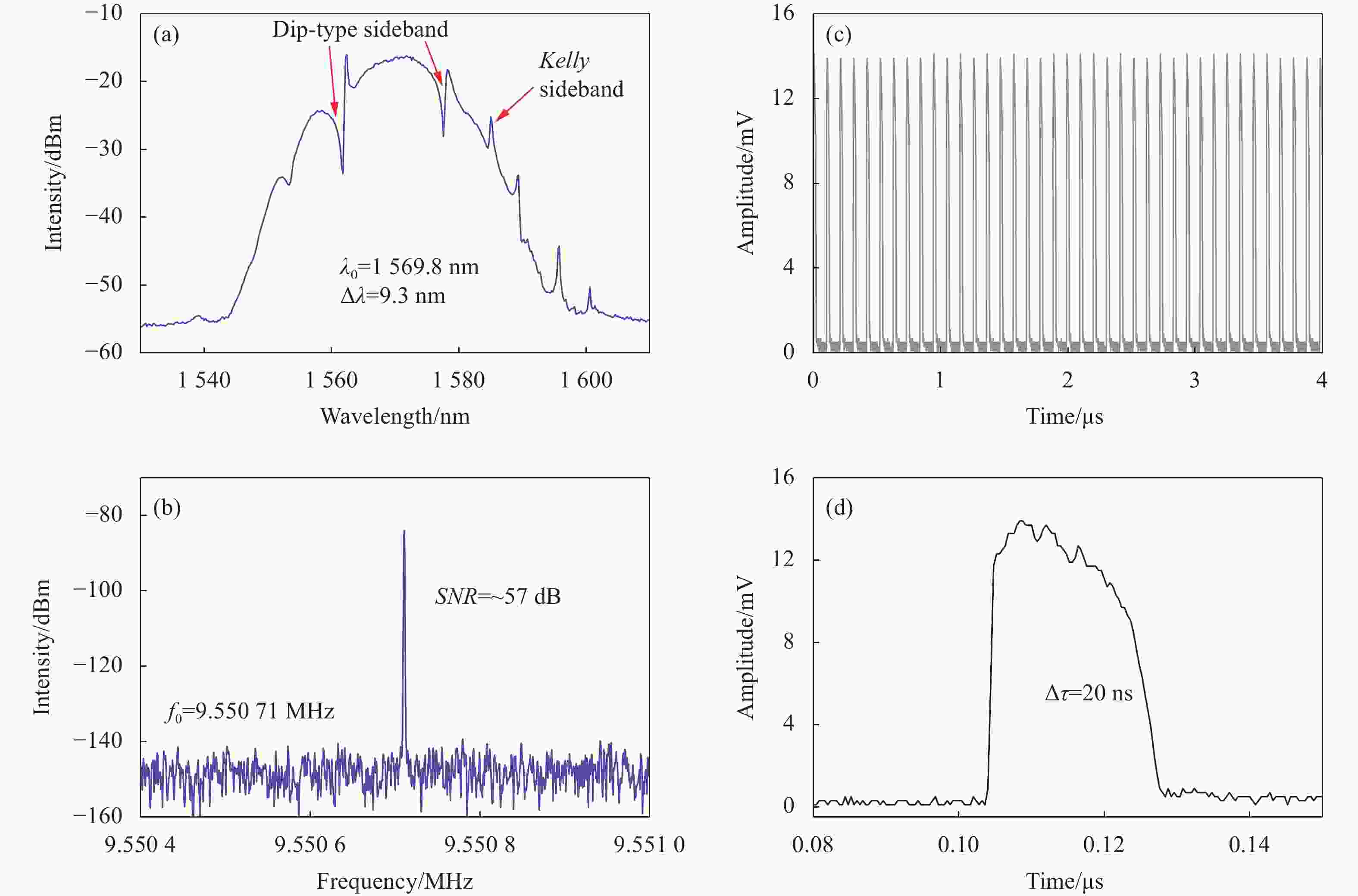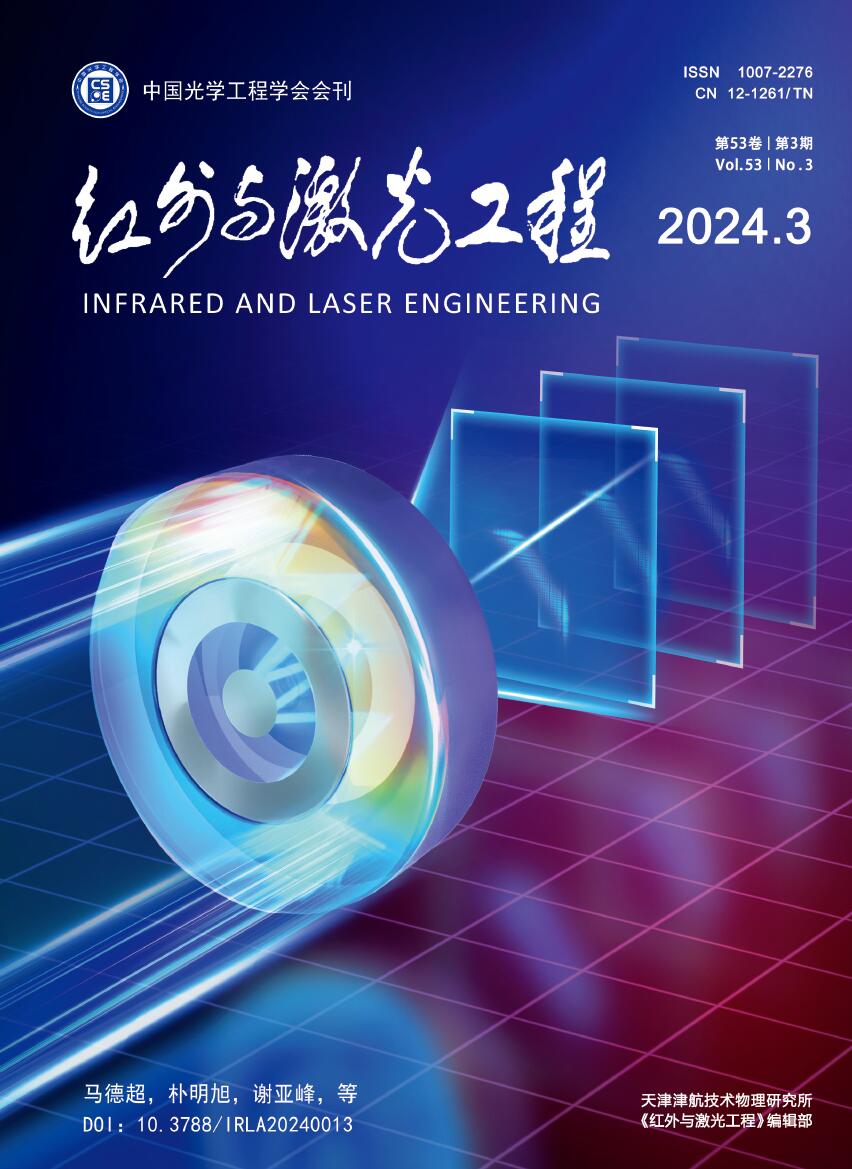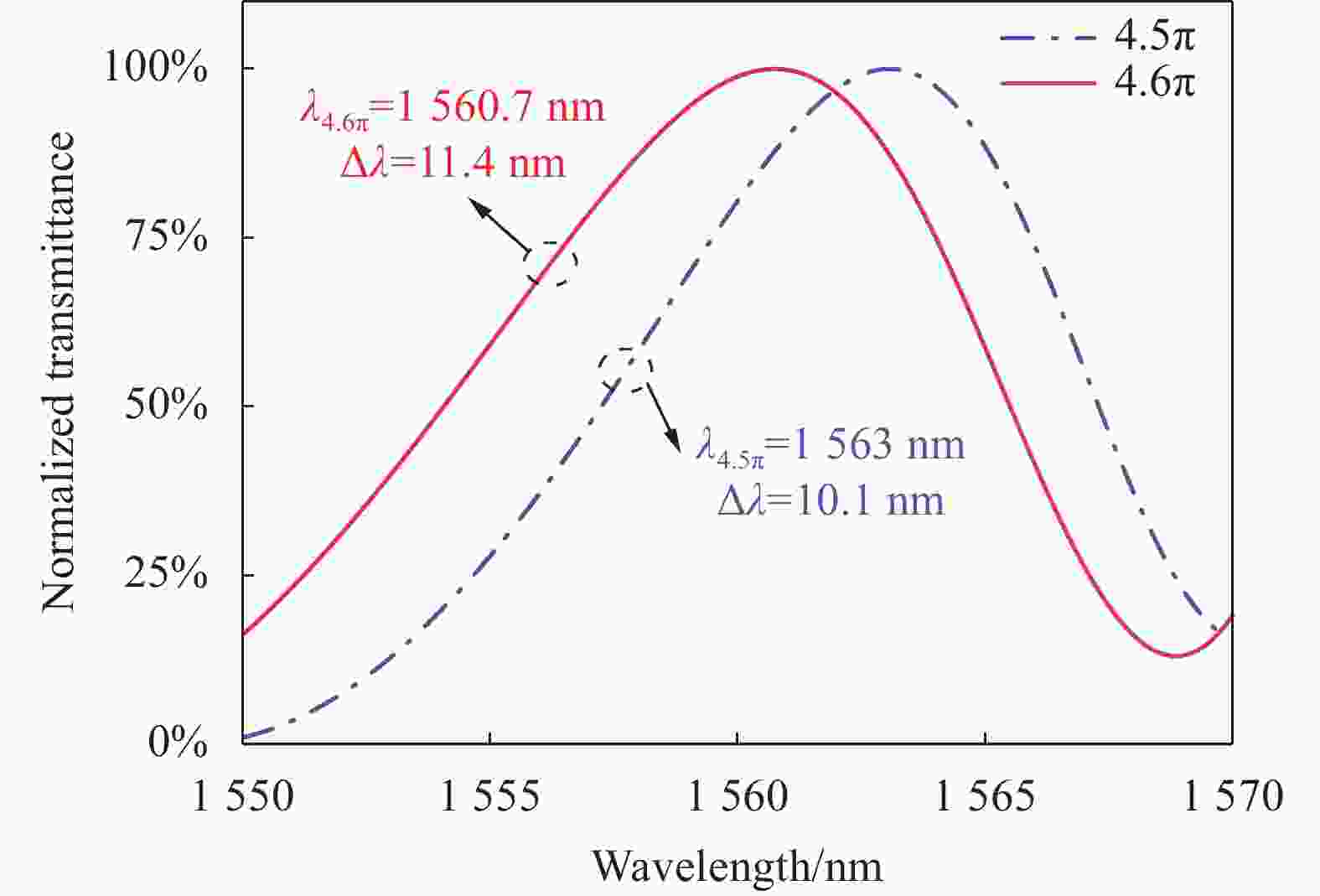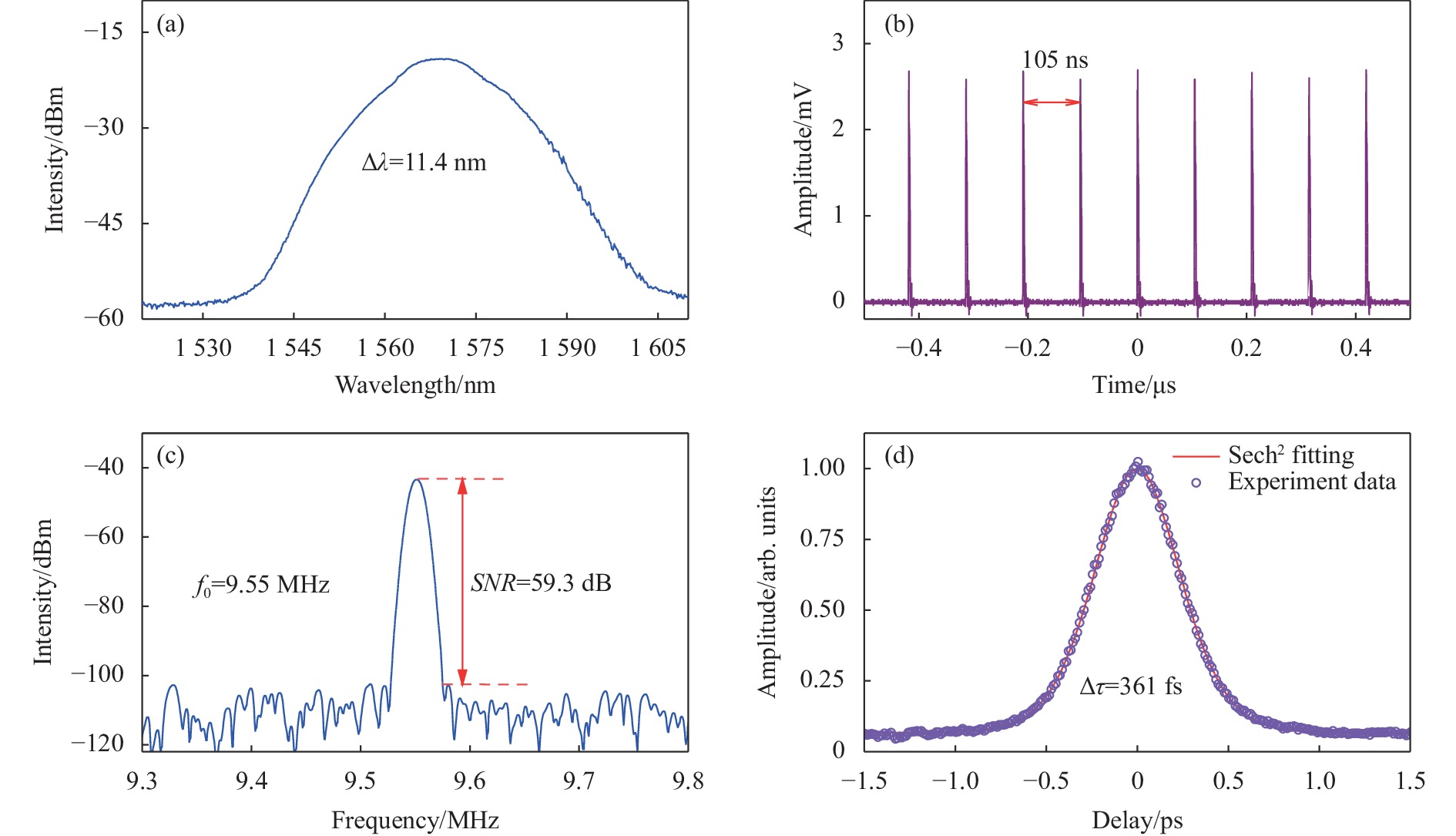-
随着现代技术的发展,对工业用器件的集成度要求不断提高,基于三维材料的基础器件难以适应新的需求。近年来,低维纳米材料凭借它们独特的光电特性和物理化学特性,在光学传感、光开关、显微成像、光通信等领域得到了广泛的关注,有望成为未来解决这一难题的新方向,所以低维纳米材料和非线性光学相结合也将是未来的重要发展趋势[1-4]。被动锁模光纤激光器由于其脉冲宽度极窄、能量高、结构简单以及价格低廉等优势,在上述应用领域中发挥着重要的应用价值[5-6]。饱和吸收体作为一个损耗元件,对被动锁模光纤激光器的自启动和稳定运行起着关键的调控作用。低维纳米材料,例如一维碳纳米管、二维石墨烯和过渡金属二硫化物等材料具有短的恢复时间和高的三阶非线性响应,在飞秒光纤激光脉冲产生领域取得了很大地进展[7-10]。但是,低的损伤阈值使得它们难以在高能量脉冲应用领域发挥作用。为了解决这一问题,L. Yun等人基于PbS量子点搭建了重复频率为13.9 MHz的1560 nm飞秒光纤激光器,实现了大于30 mJ/cm2的损伤阈值和1.69 nJ的输出脉冲能量[11]。H. Pan将石墨烯羟基功能化处理,改变了石墨烯的界面特性,并增加亲水性以降低堆叠效应,在倏逝场模式中实现了飞秒脉冲产生,最大脉冲能量为1.91 nJ[12]。
在单模光纤激光器中,由于孤子面积理论的存在,传统的飞秒脉冲能量超过0.1 nJ将分裂成多脉冲状态。耗散孤子共振(DSR)可以有效解决光波分裂问题。X. Liu等人利用Ti3C2Tx Mxene纳米薄片在1560 nm波段搭建了重复频率为7.39 MHz的被动锁模光纤激光器,实现了耗散孤子共振脉冲宽度从2.07~8.13 ns的调谐[13]。Chang等人通过耦合的金兹堡-朗道方程理论分析了DSR的产生机制,在正色散区和负色散区满足一定的非线性、增益和损耗条件时便可产生DSR高能量脉冲[14-15]。但是,如何精确调控这些参数来实现特定的高能量孤子脉冲特性仍是一个巨大的挑战。2023年,L. Hong等人从仿真角度分析了三阶色散对DSR脉冲产生的影响,当脉冲在上百米长的负色散光纤上运行时,弱的三阶色散依然可以引起脉冲时间宽度的显著增加,并导致脉冲前后沿的对称性丢失[16]。
在基于PbS量子点被锁锁模光纤激光器中嵌入一小段渐变型多模光纤(GIMF),通过拉伸的方式改变单模光纤-多模光纤-单模光纤结构滤波器的滤波特性,同时利用GIMF中“基模”群时间延迟量与GIMF长度的线性关系,可以切换激光器的运行状态。实验中,设置光纤激光器的总光纤色度色散总量满足近零色散,产生3 dB带宽为11.4 nm的展宽脉冲,脉冲半高全宽为361 fs。改变谐振腔内的偏振状态和泵浦功率,调控“基模”的群时延量实现从展宽脉冲到高能量DSR脉冲的转换,DSR脉冲的脉冲宽度在7.7~23 ns之间可调谐,当泵浦驱动电流为800 mA时,腔内最高脉冲达到34.8 nJ,表明PbS量子点饱和吸收体的损伤阈值大于60 mJ/cm2。
-
基于非线性多模干涉效应的光纤滤波器结构如图1所示,由一小段渐变型多模光纤与其两端的单模光纤(SMF)构成。GIMF中传输的导模模式之间传播模式并不是均匀的,所以存在着自成像现象,即多模干涉周期与模式传播常数失配相关。假设入射进入GIMF的基频模场E(ρ,φ,0)激发产生振幅为Ap的导模Fp(ρ,φ,0),在GIMF中传输z距离后,总光场由众多的导模模场叠加而成,仅考虑非线性情况和弱耦合条件时,导模Ap可表示为[17]:
式中:n2为非线性折射率;η为非线性耦合系数;P为导模功率;λ0为光波波长。从公式(1)可以看出,光波经过z距离的传输后,由于非线性效应产生了一个额外的相移量Δφ=2πn2ηP/λ0,这将导致多模干涉周期偏移,光强透过曲线发生变化。所以,利用非线性引起的相移量与波长的相关性可以实现光谱滤波效果。图2为数值计算得到的光纤滤波器在1560 nm附近的透过率特性曲线。仿真中使用的参数如表1所示。在单模光纤和GIMF中心对准时,GIMF中激发的模式能量主要集中在前4个模式中,所以仿真中只计算了6个模式的影响[18]。
Parameter Value Length of GIMF/cm 4.5π/4.6π Core radium/μm 31.25 Number of modes 6 Center wavelength/nm 1560 Linear index of refraction 1.471 Diameter of mode field in SMF/μm 5.6 Table 1. Numerical simulation parameters
从图2可以看出,通过参数设置,GIMF在1560 nm波段表现出了光谱滤波效果。根据前面的理论分析可以看出,多模干涉周期(即滤波特性)受到额外非线性相移量的影响。改变GIMF长度等效为改变脉冲传输过程中累积的非线性相移。当GIMF的长度为4.5π时,滤波器中心为1563 nm,带宽为10.1 nm,增加0.1π长度后,滤波器中心波长发生了蓝移,带宽增加到了11.4 nm。所以,在实验过程中,改变腔内脉冲的时延量可以实现光纤滤波器带宽的调谐,从而实现输出脉冲特性的切换。
-
实验中搭建的锁模光纤激光器装置结构图如图3(a)所示。环形激光器谐振腔包含了一段掺杂铒离子的增益光纤(EDF)、一个偏振无关隔离器(ISO)、一个90∶10输出耦合器(OC)、一个挤压式偏振控制器(PC)、一段1550 nm单模光纤(SMF)、一段24 cm长渐变型多模光纤、一个基于低微纳米材料PbS量子点的可饱和吸收体(SA),增益光纤通过一个波分复用(WDM)器件由一个980 nm的半导体激光二极管激励。多模光纤两端分别与单模光纤熔融连接组成一个光纤滤波器件,利用多模光纤中的自成像距离的强度相关特性,实现可调滤波功能。单模光纤及器件尾纤、增益光纤的长度分别为7.76、12 m,腔内总色散量为−0.037 ps2,表明激光器谐振腔处于近零色散区。多模光纤的两端分别用光纤加持器固定在一维位移平台上,通过调节任意一个位移平台位移量可以调整多模光纤的微小拉伸量,实验中,多模光纤的拉伸量设置为70 μm。实验中,使用双探测器测量方法测试SA的非线性饱和吸收特性。探测用的脉冲激光是基于非线性偏振旋转技术的锁模光纤激光器,中心波长为1565 nm,半高全宽为320 fs,重复频率为20 MHz。为了表征饱和吸收特性,对PbS量子点SA及SMF-GIMF-SMF结构分别测量透过率曲线,测量结果如图3(b)和(c)所示,可以看出SMF-GIMF-SMF结构在GIMF拉伸70 μm条件下,未表现出明显的可饱和吸收特性。从图3(b)实验数据可以看出,随着腔内激光脉冲光强的增加,SA的透过率呈现了非单调性变化,即在光强大于1.66 GW/cm2时,透过率出现了下降趋势(反饱和吸收)。因此使用以下修正后的透过率曲线拟合实验结果[19]为:
式中:A为归一化系数;ΔT为调制深度;P、Psat分别为脉冲瞬时强度、饱和强度;R为反饱和吸收系数。拟合后可以得到SA的调制深度ΔT为1.8%,归一化系数A=0.72,反饱和吸收系数R=0.01 kW−1。
-
用相同长度的单模光纤代替PbS量子点SA器件后,调整驱动电流和PC状态,激光器均处于连续光输出状态。接着,将SA替换到谐振腔内,当泵浦电流升高到245 mA时,调节PC的偏振旋转角,激光谐振腔输出稳定的锁模脉冲,如图4所示。从图4(a)所示的激光脉冲的输出光谱可以看出,色散波和孤子相互作用很弱,呈现出展宽脉冲光谱特性,中心波长为1568.6 nm,3 dB带宽为11.4 nm。图4(b)是采集的1 ms时间长度的脉冲序列,相邻脉冲之间的间隔为105 μs,对应激光谐振腔的总腔长L=20 m。图4(c)为1 Hz分辨率下测量得到的脉冲射频谱,可以看出基频频率位于9.55 MHz,信号噪声比为59.3 dB,表明输出激光为稳定的锁模脉冲。图4(d)为测量得到的脉冲自相关曲线,通过Sech2型曲线对实验数据进行拟合,可以得到输出激光的脉冲半高全宽为361 fs,计算得到的脉冲时间带宽积约为0.5,说明脉冲带有少量的啁啾成份。输出脉冲的平均功率为3 mW,对应的脉冲能量为0.3 nJ。

Figure 4. Output characterizations of stretched pulses. (a) Output spectrum; (b) Temporal trains of pulses; (c) Radio frequency spectrum; (d) Autocorrelation curve
为了研究高能量激光的产生,升高泵浦电流为296 mA,同时旋转PC的偏转角度到合适位置,激光器输出脉冲激光切换到了新的运转状态,如图5所示。从图5(a)可以看出,输出光谱的中心波长红移到了1569.8 nm,但是3 dB带宽降低到了9.3 nm,在光谱的两边出现了不对称分布的边带,说明在此时的实验条件下,同步和非同步色散波共存于谐振腔中,局部的非同步色散波和孤子之间发生了相消干涉效应产生了宽带的dip型边带,而同步的色散波和孤子相互作用产生了典型的Kelly型边带[20]。

Figure 5. Output characteristic at a pump current of 296 mA. (a) Output spectrum; (b) Radio frequency spectrum; (c) Temporal pulse trains; (d) Time-domain waveform of pulse
为了进一步研究边带特性,根据相位匹配原理,dip型边带和Kelly型边带与中心波长的间隔可表示为[21]:
式中:m为整数,代表光谱中心波长两侧的边带阶数;τ0为脉冲的归一化时间宽度;${Z}_{0}=0.5\mathrm{\pi }{\tau }_{0}^{2}/\left|{\beta }_{2,{\rm{avg}}}\right|$为孤子脉冲周期,β2,avg为实验中谐振腔的平均色散量,λ0=1569.8 nm为脉冲的中心波长。根据多模光纤中“基模”的偏振特性和时延关系[22],改变PC的偏振状态引起线性模式群时延量增加(腔内总色散量变大),多模光纤的滤波带宽降低。同时随着泵浦功率的增加,饱和吸收体进入到反饱和吸收区域,引起锁模状态的变化。根据Kelly边带特性[23]及相位匹配原理,可以计算得到此运转状态下的腔内平均色散量为−18.9 ps2/km,于是便可以计算得到1阶dip型边带的波长位置距离中心波长8.02 nm,与实验结果相一致。
输出激光的射频谱如图5(b)所示,信噪比约为57 dB,基频频率为9.55 MHz,对应图5(c)脉冲序列中相邻脉冲的时间间隔。该状态下的锁模脉冲无法测量到自相关曲线,所以用一个6 GHz的光电探测器与一台4 GHz带宽、20 GSa/s的实时示波器测量单个脉冲波形,如图5(d)所示。可以看出,此状态下的脉冲呈现出近似矩形的包络,半高全宽为20 ns,此时输出脉冲的平均功率为12.5 mW,输出脉冲能量为1.3 nJ,腔内脉冲能量为11.7 nJ,类似负色散区的耗散孤子共振脉冲[14-15]。在谐振腔中,由于反饱和吸收效应和峰值功率钳制作用,使得脉冲的宽度可以被无限制地展宽而不发生分裂。
保持PC的偏振旋转角不变,仅改变980 nm泵浦驱动电流的大小,可以得到近似矩形脉冲的时域宽度和输出平均功率的演化趋势,如图6所示。实验中,驱动电流从300 mA开始,每间隔100 mA用示波器测量单个脉冲的时域波形,测量结果如图6(a)所示,随着泵浦驱动电流的增加,脉冲形状基本保持不变,但是时域宽度逐渐增大。测量得到的输出脉冲平均功率和脉宽变化曲线如图6(b)所示,从图中可以看出,脉冲宽度和能量与泵浦功率近似呈现线性关系。当驱动电流增加到800 mA时,输出脉冲的半高全宽为23 ns,输出的平均功率为37 mW,由此计算得到的输出脉冲能量为3.87 nJ,对应腔内循环的单脉冲能量为34.8 nJ,由此可知,PbS饱和吸收体的损伤阈值大于60 mJ/cm2。2022年,基于PbS/CdS量子点饱和吸收体Shen和Chen等人在掺Er光纤激光器中实现了高能量的调Q脉冲和传统孤子锁模脉冲[24]。相比之下,文中有以下不同和改进之处:1)增加了基于多模光纤的可调谐光谱滤波器件,并利用多模光纤中“基模”引起的群时延偏振特性,通过调节腔内偏振实现对滤波带宽和腔内色散的调控,实现锁模脉冲运转区域的切换;2)文中实现的两种锁模脉冲稳定性更高,信噪比比文献[24]高近10 dB,同时输出光谱宽度增加了3倍多;3)文中不仅实验得到了两种锁模脉冲输出特性,同时从理论和数值计算方面对其中的物理机制进行了分析。
-
文中基于低维纳米材料PbS量子点搭建了被动锁模光纤激光器,在近零色散区实现了3 dB带宽为11.4 nm,半高全宽为361 fs的展宽脉冲。利用多模光纤中多模干涉周期的波长相关性和强度相关性,将一段24 cm长的渐变型多模光纤装配到谐振腔中充当可调滤波器。由于GIMF中存在的偏振相关“基模”模式,其群时延量和GIMF长度呈现线性关系,改变腔内偏振状态即可实现调控腔内总色散的目的。升高泵浦驱动电流到296 mA时,展宽脉冲切换成了类矩形脉冲,三阶色散的影响导致脉冲前后沿呈现不对称波形。保持PC状态不变,升高泵浦驱动电流,输出脉冲半高全宽实现了从7.7~23 ns的变化。当泵浦驱动电流达到800 mA时,输出脉冲平均功率为37 mW,对应PbS量子点的损伤阈值大于60 mJ/cm2。这种高能量、可调谐的被动锁模光纤激光器在工程应用和科学研究中都有重要的作用。
Tunable high-energy mode-locking fiber laser based on PbS quantum dots
doi: 10.3788/IRLA20230632
- Received Date: 2023-10-09
- Rev Recd Date: 2023-11-10
- Publish Date: 2024-03-21
-
Key words:
- PbS quantum dots /
- high-energy pulses /
- mode-locking fiber laser /
- multi-modal interference effect
Abstract:














 DownLoad:
DownLoad:




